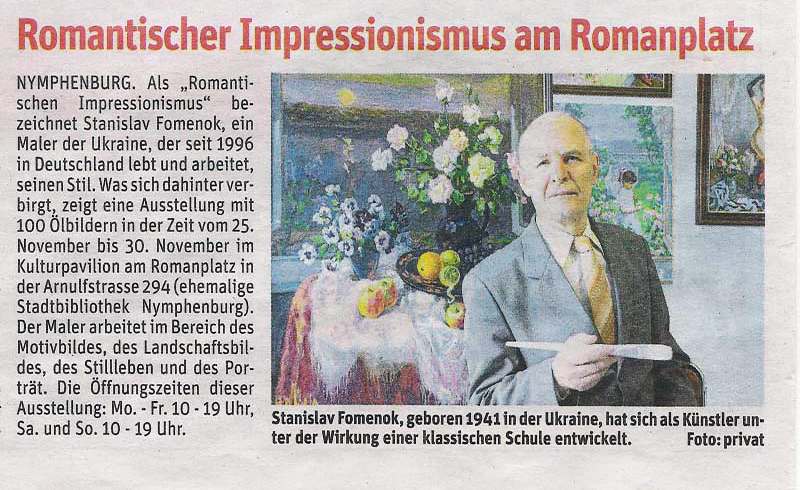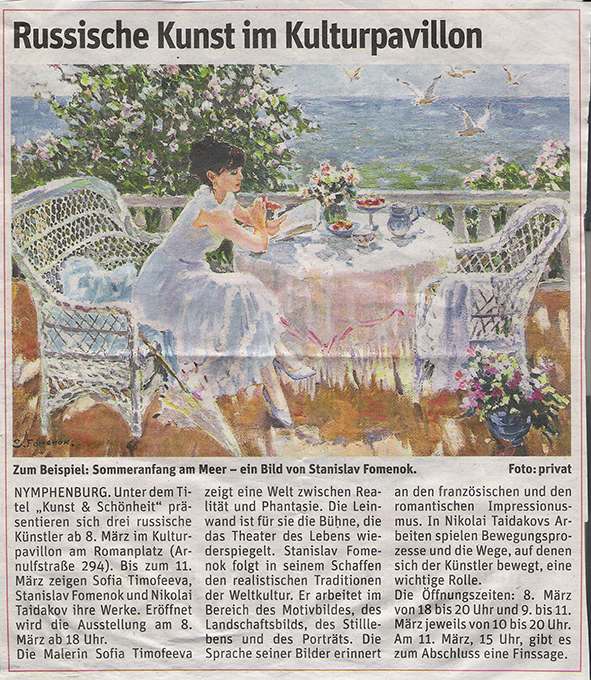Igor Trush. Art critic. Leading scientific employee of a museum.
 Time is being recorded by artists as well, as it is one of the most elusive, many-sided aspects of human existence. Time, as any phenomenon, cannot be merely pictured and unambiguously interpreted - that is why it is so attractive both for the artist being the creator, and for the audience.
Time is being recorded by artists as well, as it is one of the most elusive, many-sided aspects of human existence. Time, as any phenomenon, cannot be merely pictured and unambiguously interpreted - that is why it is so attractive both for the artist being the creator, and for the audience.
The exhibition space of the four halls of the Dnipropetrovsk Art Museum is filled with Stanislav Fomenok's paintings, representing different years: from the 1960s to the 2010's, to the present time. This period, quite close to us, covering the turn of the twentieth century, is quite rich in various historical events both in our country and in the whole world. Being a witness, a bystander to the events, the artist did not remain an indifferent observer of the surrounding. His creative method has gravitated and is still gravitating to the intention to portray the moments of life, as the author himself notes, "preferably attractive, beautiful" - in all their variability and liveliness. And in such a way that these clearly fixed moments would then encourage the audience to day-dream, to develop the scenes seen in the picture in their imagination.
The artist's diverse representation of the passing time makes it possible to assess the depth of his talent, as well as to feel the orientation and character of the pictorial comprehension by a creative person, a citizen, our contemporary, of one of the most difficult periods in the history of mankind.
As for the author's relationship with the authorities, Stanislav Fomenok was valued by it, which was evidenced by the title, personal exhibitions, ministerial purchases, social status, leadership positions, trips abroad with the delegations of the Union of Artists, but this did not dampen his inner sense of the contemporary life instability, which was inherent in most of the intellectuals of the time due to the incomprehensibility of social ideals, unclear humanistic ideas, degradation of aesthetic and ethical attitudes. In 1996 the artist decides to move to Germany, to Munich. New acquaintances and new impressions promote his creative activity, freed from all kinds of ideological attitudes, external guidelines, censorship pressure. Educated in a school of realism, a supporter of figurative art, he reveals a vivid, genuine interest in the creative work of the brothers of the brush of different trends of European art of the twentieth century.
Of course, creating the present personal exhibition, it would be easier for the author to show his landscapes, portraits, still-life paintings, genre paintings as a part of the 50-year biographical retrospection, but Stanislav Fedorovych deliberately suggests to perceive in the exposition the presence of another actor, besides the Artist and the Audience - the Time. In the context of the name of the exhibition, it appears in various incarnations.
First, it is impossible to ignore such an important social aspect as "The Artist and the Time": Fomenok is a child of his epoch, he lives in time and his art is consonant with him, he records and reflects what he sees - and it will always be fundamentally different, passing into history, in correlation with the new today. To make sure this is true, it is enough to compare the colour, the manner of presentation in the works of different years: "On Duty. 1974 ", "Summer. Cherry. 1975", "Portrait of the Worker. 1980", "Portrait of a Son. Ruslan. 1989", "Peace to Our Land. 1988", "Youth. 1999" and so on.
Sometimes the author acts as a representative of memory, explaining the past with his large-scale works, turning us - people of the XXI century into contemporary eyewitnesses. It seems important to us that with a reliable graphic fixation of this event, absolutely true in details, with the silent evidence of the past, the Author has the exclusive right to interpret the unspoken remark of the Memory itself. He does not want the forgetfulness of modern times to turn the past into an unresolved problem, giving rise to chaos in today's minds, suppressing with the unbearable burden of the un-lived and unremitted past (for example, "The Stout-Hearted. 1973"; paintings dedicated to the events of the civil war - "We Prepared the Horses for the March. 1976" and the Second World War - "After the Battle. 1985", "In the Forest near the Front. 1983"; Easter still-life paintings of 1980 and 1983). There are already two chronological perspectives - historical (actual past) and modern (the current perception of those events). The interconnections of these times forms a kind of semantic diptych between the picture and the thoughts about how a particular past influences the future, defines it and impacts on the fate of the artist, his contemporaries and descendants.
Stanislav Fomenok's past may also become apparent as a hint, a graceful variation of a previously seen scene or topic, proving once more that there is nothing new in this world. The most representative works-reminiscences in this regard are as follows: "In the Morning. 2006" (T. Yablonska), "Geese on the River. 2004" (M. Pymonenko), "Expectations" and "Spring in the Yard. 1999" (C. Monet), etc. Although it is possible that the author may not even guess of the existence of "this echo from the others".
The artist liked the technique of placing a picture in the picture, so it is not by chance that in his several exhibitions there are the quotes, references to other classic paintings or to his own. For example, "Dream. 1984", "Morning. A New Day. 2014", "At the Picasso Exhibition. 2015", "Self-Portrait. 2015".
A variety of such an attitude to the time is some of the works of Fomenok, the theme or motive which is repeated over the years. While comparing such works with each other, a question suggests itself: is it possible for the author to retain "that particular" feeling? Once the impressions and perspectives have been found, as well as the forgotten emotions of the artist himself and other people, the transmitted sensation of the berries sweetness or the specific aroma of flowers - can this all be turned back? Is it recognizable as "that particular"? Indeed, as you walk along the streets, the flow of cars and passers-by, the diamond spray of the fountain and the appetizing smell from the roadside coffee shop becomes a reality of the present and remains even when the walk is in the past, and the noise of the street is left outside the walls of the house. Bringing up on the surface the present image of numerous things and events, the past appears in every centimetre of the picturesque surface of the picture as the possibility for the manifestation of something invisible. However, at first, those initial pictures accumulated other feelings, actions and words that are now awakening with the forgotten taste and smell. Such unexpected pairs as the "Bride." 1975" and the "Portrait of a Girl. 2015", "Maryna. 1975" and "Natalia. 1988", "Sunny Land. 1978" and "Sunflowers and Fruits. 1994" etc., actually, do not bring us back the same emotions, the same smell or taste, but give the opportunity to fit one inside the other, where the viewer becomes the accumulating unit, keeping those different things. In fact, this is called a memory. In this sense the work "Lilac in Bloom," which was painted from 1985 to 2015, is unique.
Another feature of time representation can be seen in the works of Stanislav Fomenok - this is a portrayal of details of "past" in the "present" at the time of painting a picture. Quite often, this artistic technique is used when painting women's accessories (women's hats, sun umbrellas, boa, long gloves of different colours and styles) or paintings, which depict children (toys from other material environments - the epoch of forgotten childhood, old-fashioned boots and so on). There are garden retro shops or bentwood chair appearing in the landscape background. These attributes of the past are reproduced in the present, most likely, unconsciously - this is the result of the automated professional habit of the artist to emphasize the beauty and elegance with details. (See: "Girls Playing. 1998", "Summer Day on the Balcony. 2001", "Morning on the Lake. 2006", "Summer Coffee Shop. 2008" etc.).
Fomenok's creative work also includes a significant amount of paintings, where time and place are recorded, specified by a date, a name. These are the landscapes and plot sketches of those places that Stanislav Fedorovych liked. Especially great number of such paintings are dedicated to the city of Munich, where he now lives (for example: "Evening in Munich. 2009", "Summer Coffee Shop. Munich. 2011", "On the Odeonsplatz in Munich. 2012", "Marienplatz. 2007", etc.). And vice-versa, there is an entire group of paintings, in which time seems to have stopped or moves slowly, in a special way, despite the specificity of portraying the day or night of one of four seasons of the year. The timelessness is characteristic of the author when he paints still-life, nude, ballerinas, and dancers. Through the power of his inspiration the artist forces the viewer to stop, freeze and be astonished. The master, with the help of light-and-dark modelling, the ability to build a composition, focuses our attention on the eternal beauty of nature, grace and elegance, but at the same time on the fragility of the human body. This interpenetration of eternity and momentum gives the notes of joy from experiencing this miracle... and the sadness that everything will sooner or later go away.
The works of the "Soviet" and "Munich" periods, presented in a fairly diverse way to the audience at the exhibition, clearly demonstrate what excited and inspired our compatriot, how his worldview and outlook evolved, which thoughts and discoveries he was ready to share and is now sharing with the world around him. We can state that today's contemporary domestic society, with all its contradictions, does not interfere with the objective understanding of the content and graphic poetry of art of Stanislav Fedorovych Fomenok. This allows us to free us from the still dominant ideological clichés, the established stereotypical definitions for his work, and look at the already known works of the artist in a different, fresh eye, as well as to have an non-prejudicial look at his new German works.
As for the time, as the poet Yurii Levytanskyi wrote, it is a "fearless artist" that painted us from the very
... first cry
and to the last breath
time writes in its own manner and style
(era, age, and epoch).
Writes in a conditional manner
and as they once wrote.
Just like they write on a square plate
a sad date.
Reflections. Glare. Glitter.
Spots of white and gouache.
Our sinless faces.
Our sinful images...
Stanislav Fomenok still has to pass the test of time, and I want to believe that his work will not suffer from "corrosion". We would like to wish him, in the distant future, to endure this perceptive gaze of eternity with dignity.
Igor Trush. Art critic. Leading scientific employee of a museum.



















